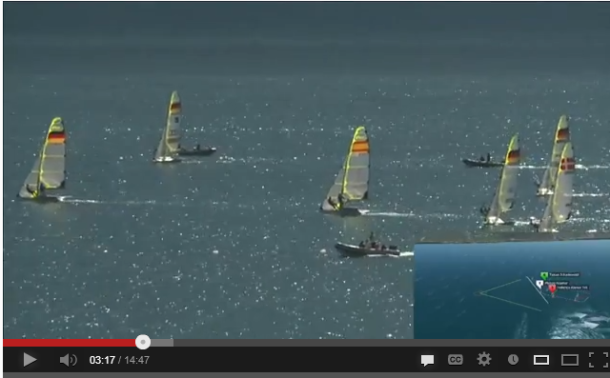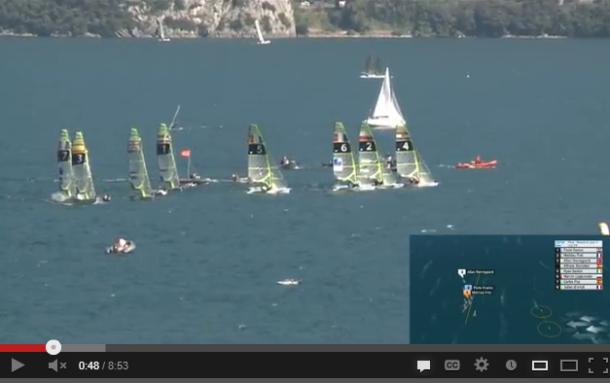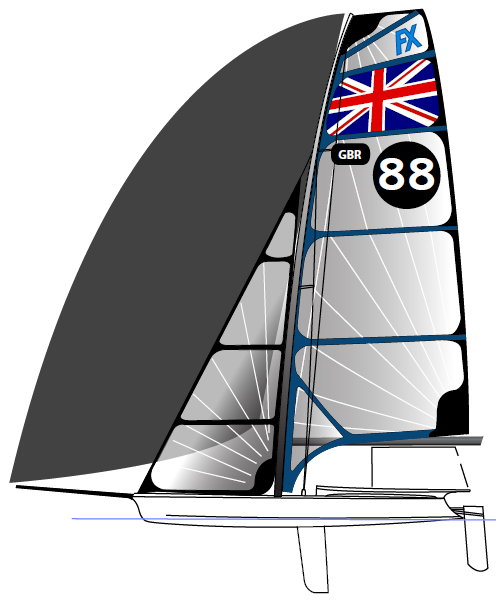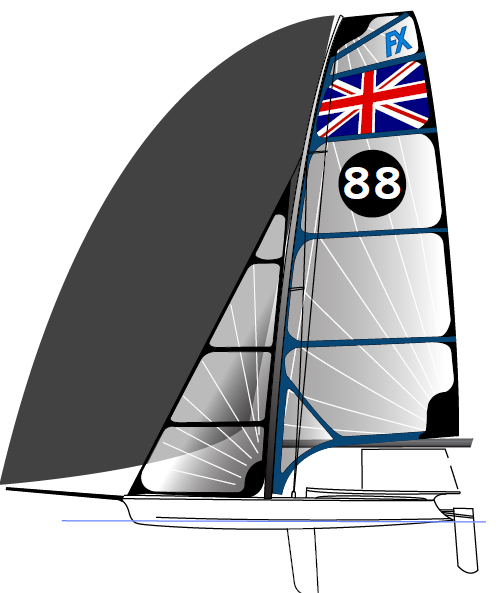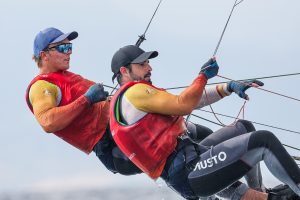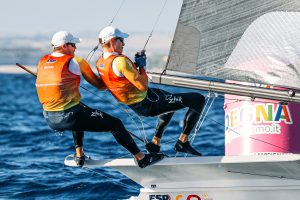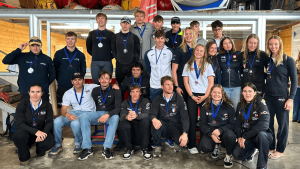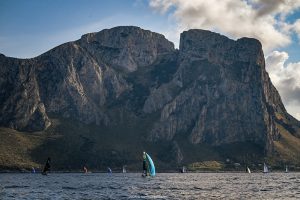Root Purpose – Reason for Change
The 49er class is trying to create a media product worth broadcasting. We have a number of initiatives to accomplish this difficult task, including changing the format of our racing, reducing the numbers of boats in the finals,shortening some of the races, and making the boats more easily identifiable to sailing fans. We are doing this while maintaining our sporting focus of having a fair event that produces a worthy champion.
In September 2012, we tested many of these concepts at our European championships and it revealed one breakthrough, the amazing power of simple number communication. We had flights of racing and the teams 8-16 raced with the old style numbers and couldn’t tell them apart. Then in the finals we had teams placed 1-7 race with huge, simple, numbers and it was a much better product. Here are 2 photos and 2 video links to illustrate the problem and solution.
Example of the Problem and Solution
Without big numbers – which german team is which, photo first, then video.
With big numbers, photo first, then video
Our Path to a Complete Solution
Numbering
We identified the problem ahead of the 2012 Europeans, but for logistic and economic reasons, the solution we found was temporary and limited in scope. Overnight, before the final day we rebranded the top sailors boats. This involved bringing in a logo printer, removing the sail numbers from the top 7 boats, breaking our class rules by using a different identification system, and a cost of about $3000 which all had to be reversed after the day it was over.
Clearly that is not a long term solution.
You will also note that a long term solution can not work with single digit numbers, as there are not enough numbers to go around. We did some research and worked out what can work.
– There are dramatically fewer than 1000 teams racing 49er or 49erFX at any time, so a 3 digit number can cover the whole class.
– 3 digits is still ‘too many’ for an optimal solution for TV, however, so we decided that we could require any teams who have made a gold fleet at worlds (~top 25 each year) must have a 2 digit number. Back checking through all the 49er worlds’ results showed that if this solution were in place right now, 55 of the 99, 89, numbers available would be used up.
– Some of the top sailors requested that if they finish in the top 10 they be allowed (but not required) to sail with numbers 1-10 for the year. They feel that while trying to be branded as a team, the use of numbers 1-10 might be better as it shows how well they did at least years worlds. Anything to help the teams brand themselves is helpful, so that part of the rule was added to allow for the opportunity should they decide to use it.
– The way it works is everyone who starts racing a 49er chooses a 3 digit number that is available. They keep that for the life of their 49er career until they make gold fleet. Then they switch to a 2 digit number which they keep for the remainder of their career unless they finish in the top 10 at which point they may use that finish place for the year.
– There are enough number to do this system for both the 100-999 group and 1-99 group. The class will manage this internally, which is why these details are not included in the ISAF rule change submission.
– Personal sail numbers will also be issued for free to any team who is a member of the class, and we will not be charging to register personal sail numbers.
Country Code
Once it was determined possible to have a unique number for every team, the next step was in presentation. It was determined that the optimal solution is to remove the country code from the sail for a number of reasons.
– 49er sailors already have giant country flags that are more visually appealing and visceral than country codes.
– The main purpose of the initiative is to make the numbers large enough to be seen from a distance. For example, a 1 digit numbers will be bigger than the 2 digit numbers, which will be bigger than the 3 digit numbers. In each case the fewer digits allows the number size to increase.
– Including the country code adds 3 extra digits making it very difficult to have the numbers any larger than 300mm given the size of the sail. That is the size they are now and the above showed how tough that is to use. Having the country code also adds little informational value because of the national flags. There are cases where flags are similar, for example New Zealand and Australia, Italy and Ireland. Our hope is that any fan having trouble figuring out who is who will look to the score sheet and find the team using the unique sail number to figure out who is who. The same scenario happens now when teams are from the same country, and have the same flag, yet when the numbers are so small there is no way to figure out who is who as the number is too small to read.
Visual Options
The class mocked up dozens of options for how to display the country code in other ways than right beside the sail number in the traditional way. We looked at:
– Having it either vertical or horizontal in the flag panel
– Having it as a soft impression built into the flag
– Having it small in the number circle
– Having it as a separate sticker
– Having boxes, rectangles, angles, and circle for shapes
– About 10 fonts and chose News Gothic Bold Font due to it’s hint of style with general practicality.
It was determined to be very difficult to build the country code into a nations flag because of all the different configurations of flags and because of political sensitivities about making alterations to flags. We did not pursue any of the options that included working the country code into the flag.
That left 2 options:
- Have a separate sticker
- Add the country code into the number area.
There were no good visual options for including the country code into the same space as the number. In all cases except when the country code was quite small (~100mm) we were forced to make the numbers too small or to have a funny configuration.
The 49er class wishes to have the country code omitted from our sails completely. We feel that this is a strategic issue rather than a technical one. It makes no difference to race officials, race committee, umpires or judges. Removing the country code does affect ISAF stakeholders, the MNA’s. However, the requirement to carry a very large country flag on the sails does go a long way to mitigate that risk, if not improve upon our service to MNA’s.
Such a radical change is a step too far right now on the timeline on which the 49er class wishes to act. Instead, we are presenting a second choice to be put for a vote.
The selected options is using a separate sticker with the country code at 300mm. This does add to the sailors costs and forces us to move the number circle to the leech of the sail from the middle of the sail, but it is still visually appealing. The only issue, visually, is that on one side it will read backward. Instead of CAN 23, it will be 23 CAN, but as they are on separate stickers and different sizes it is a manageable problem and the best compromise.
The proposal
Here is what we are proposing which includes country codes. The non-country code option, which has already been rejected on technical grounds, is below for reference.
With Country Code
Without Country Code
Impact on Race Committee
The class has discussed this change with our race officers in all aspect.
Placement. Initially we had the number placed at the front of the sail to make it easier on the start line. The race officers (for 49er) prefer it at the leech. They report not to have a problem identifying boats at the start line, but rather have trouble at the finish line when the overlapping spinnakers can block part of the mainsail. They requested we move it toward the leech.
Recording finishes. Our race officers report that they record only the numbers anyways when they record finishes as it takes less time when 30 boats go through the finish line within 2 minutes of each other. They say the switch will make no change to how they do their work now.
Visually. They noted that they have a lot of difficulty reading our black numbers on white panels when the sails are back lit by the sun. The reverse side shows through confusing the numbering. This solution would eliminate that problem.
Timing
The media side of this is a pressing concern for the 49er class.
It is highly likely, that we will have our 49er world championships live on Danish TV for the final 3 days of our European championships for 3-4 hours each day. This is not signed yet, but we’ve already had production meetings and verbal confirmation. It will also be available to the world through livesteam over the internet.
It is very rare to have this kind of opportunity in sailing other than in the America’s Cup. This is Olympic sailings’ opportunity to use. In the 49er class we are working very hard to make the most of this opportunity. We want to make this a long term viable product for sailing fans over the world to get access to the sport they love.
The sail number is only one piece, but it is very important. If fans can’t follow who is who through the race they can not get emotionally invested. If broadcasters can’t tell who is who, they can not explain the story of what is going on.
Conclusion
- 49er class association member will vote on this proposal at an electronic special general meeting by May 3, 2013
- We will look to enact this number system ahead of the 2013 Eurpean Championships. If ISAF can act on this request quickly, we can take best advantage of this regatta and get the most media advancement we can to build media and fans. The Europeans will be on TV in Denmark, where 49er sailing is very popular due to the 2008 gold and 2012 bronze medals. Both of those teams (2 teams) will be racing along with another 10 Danish teams. If the Danish audience can’t tell who is who, they will likely not be nearly as emotionally invested and we lose an opportunity to engage them in 49er sailing for the long run instead of just at the Olympics. The same goes for the 10 British teams, 10 German teams, 5 Polish teams, 10 French teams, 8 Spanish teams, etc.
Here is a great example of what is possible some 49er racing with excellent TV coverage. Lets keep improving our systems so that when we do get TV coverage, we make the most of it.
- The sailors and media want this, as does the sailors have been included in the process from the start and want this solution. They got to look through all the design options and help us design the numbering solution.
- They like carrying the same sail number over long periods, as they go forward from boat to boat, from year to year.
- They can build a ‘brand’ around their sail number
- They can benefit tremendously from better media exposure and increased watch ability of the racing.
- Our primary media partner, SAP, have been involved from the start of this number change program including underwriting the 2012 test and supplying design options

